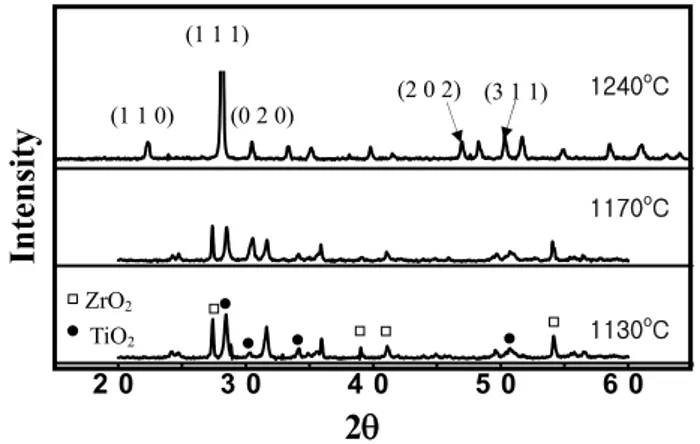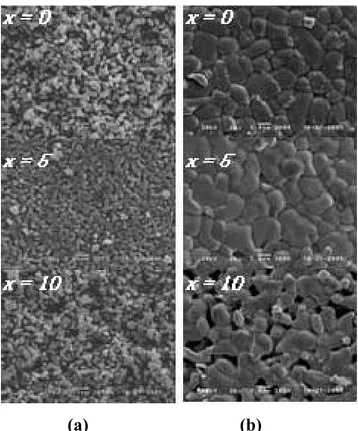© Korean Powder Metallurgy Institute 822 -1. Introduction
Zirconium titante (TiZrO4) has been utilized as dielectric resonators and it is also interesting for a wide range of applications including catalyst and high temperature pigment, etc.
Many advanced engineering ceramics usually require small dimensional tolerances. The green compact may show deviations from the original die geometry after firing. Therefore, the controlling of sintering shrinkage is very important for a geometrically scaled replica of the corresponding unfired green body.
In this study, the compaction and sintering behavior of Al2O3 modified ZrTiO4 (ZT) were investigated by means of
the measurement of sintering density and shrinkage, and the observation of microstructure.
2. Experimental and Results
Starting materials were powders of ZrO2, TiO2, and Al2O3.
ZrTiO4 (ZT) powder was synthesized by the solid state
reaction of thoroughly ground mixtures of ZrO2 and TiO2
powders that were milled in the required stoichometric ratio. The milling operation was carried out for 6 h in ethanol using ZrO2 balls. After drying at 60oC in vacuum oven, the
mixed powder was calcined at various temperatures ranging from 1130 to 1240oC in order to synthesize the zirconium
titanate. Calcined powders were investigated by X-ray diffraction to identify the phases formed as shown in Fig.1. It should be noted that ZrTiO4 (ZT) of orthorhombic
structure is formed at 1240oC.
To study the sintering behavior of ZT as a function of the content of Al2O3, the compactions with compositions of (100-x)ZT - (x)Al2O3 (x = 0, 5, 10wt%) were prepared by ball milling for 1 h, binder mixing (weight % ratio; powder/PVA =85/15) for 12 h, and uniaxial pressing to produce pellets 40 mm in length ×30 mm in width ×10 mm in height. Pellets were sintered at temperatures between 1300 and 1500oC for 3 h in air.
Fig. 1. XRD patterns of ZT powder calcined at three temperature.
Fig.2 shows the ceramic samples sintered at 1300, 1400, and 1500oC. For the samples sintered at 1300 oC, it should be noticed that camber appears with increasing the content of Al2O3 in ZT. However, these cambers disappear with
increasing sintering temperature above1400 oC.
The ceramic samples are very porous in sintering at
2006 POWDER METALLURGY World Congress
B06-09-1
2 0 3 0 4 0 5 0 6 0
Compaction and Sintering Behavior of Al
2O
3-modified Ziroconium Titanate
(ZrTiO
4)
Myoung Pyo Chun1,a, Hur Geun1,b, Seung Jae Myoung1,c, Jung Ho Cho1,d, and Byung Ik Kim1,e 1
Advanced Materials & Components Team, Korea Institute of Ceramic Eng. & Tech., 233-5, Gasan-Dong, Guemcheon-Gu, Seoul, 153-801, Korea
a
myoungpyo@kicet.re.kr, bgjrms3@nate.com, cmsj7179@hanmail.net,
d
goedc@kicet.re.kr, ebikim@kicet.re.kr
Abstract
The compaction and sintering behavior of zirconium titanate (ZrTiO4) was investigated by means of the measurement of
sintering density and shrinkage, and the observation of microstructure. With increasing the content of Al2O3 additive,
Al2O3-modified zirconium titanate samples fired at 1300oC showed the anisotropic shrinkage behavior that the upper region
of sintered body has higher sintering shrinkage than the low region. This difference of sintering shrinkage decreased with increasing firing temperature from 1300 to 1400oC. The SEM micrographs of powder compation show that the anisotropic shrinkage behavior is related with non-uniform density in a uniaxial compaction.
Keywords : Zirconium titanate, compaction, sintering, shrinkage, density
1130o C 1170o C 1240o C (1 1 0) (1 1 1) (0 2 0) (2 0 2) (3 1 1) ZrO2 TiO2
2
θ
Intensity
© Korean Powder Metallurgy Institute 823
-1300 oC and dense in sintering at 1500 oC as shown in Fig.3.
Therefore, the camber formed in the samples sintered at 1300 oC seems to be related with the difference of green
density or sintering shrinkage between upper and lower region of pellets.
Fig. 2. Photographs of samples sintered at (a) 1300oC, and (b) 1400oC for the compositions of (100-x) TZ - (x)Al2O3 (x = 0, 5, 10 wt%).
Fig. 3. SEM micrographs of samples sintered at (a) 1300oC,
and (b) 1500oC for the compositions of (100-x)TZ -
(x)Al2O3 (x = 0, 5, 10 wt%).
Fig.4. shows the SEM micrographs of the uniaxially pressed compact of composition (95wt%TZ – 5wt%Al2O3). It is shown that some cracks are observed in the lower region of green compact. So, the green density of the lower region seems to be less dense than that of the upper region. The camber that appears for the samples sintered at 1300oC
is considered to originate from the difference of green density between upper and lower region of compact.
Fig. 4. SEM micrographs of compact with composition of 95wt%TZ–5wt%Al2O3 uniaxially pressed at 1 ton force. (a) upper region, and (b) lower region of green compact.
The reason that the camber disappears for the samples sintered above 1400oC seems to be related with mass
transport of particles and diffusion of atoms toward less dense compact region during the sintering.
3. Summary
The compaction and sintering behavior of zirconium titanate (ZrTiO4) was investigated by means of the
measurement of sintering density and shrinkage, and the observation of microstructure. In case of Al2O3-modified zirconium titanate (ZT), camber appears for the samples sintered at 1300oC. But, this camber disappears with
increasing the sintering temperature above 1400oC. The
anisotropic shrinkage behavior is considered to be related with the difference of green density between the upper and lower region of green compact.
4. References
1. K. Wakino, K. Minai, H. Tamura, J. Am. Ceram. Soc., 67, 278 (1984).
2. F.J. Parker, J. Am. Ceram. Soc., 73, 929 (1990).
3. B.J. Briscoe, S.L. Rough, Colloids and Surfaces, A., 137, 103 (1998).

